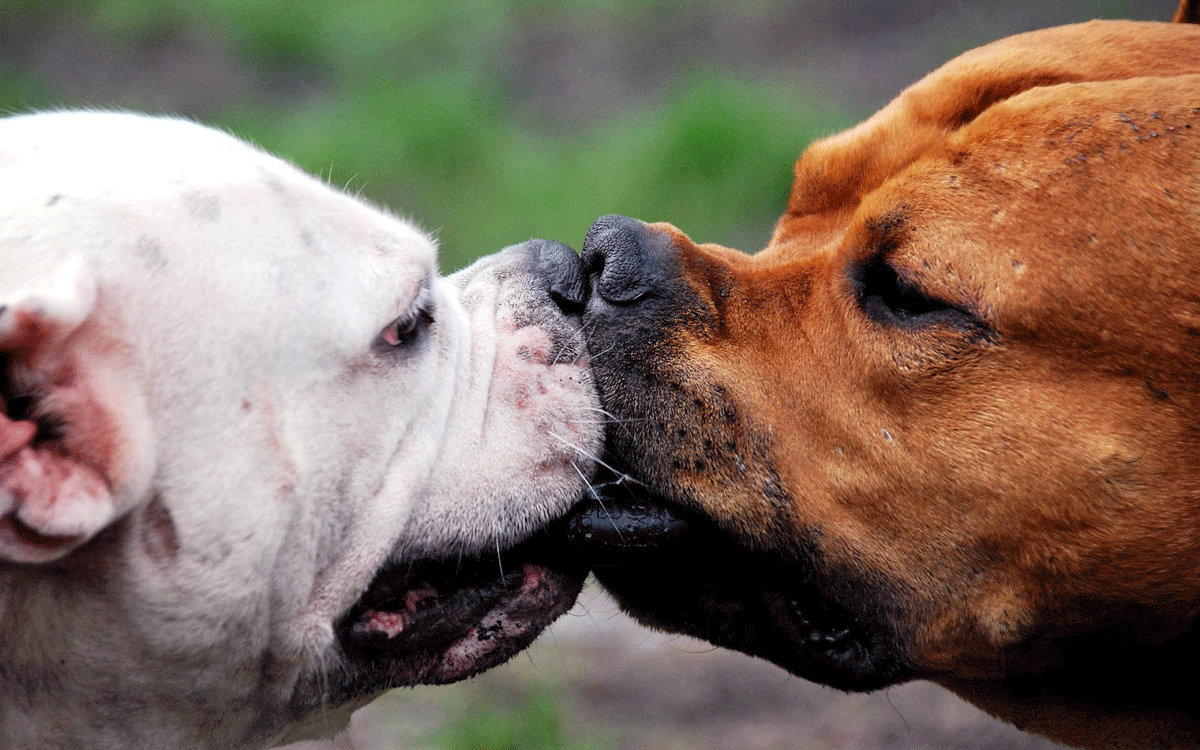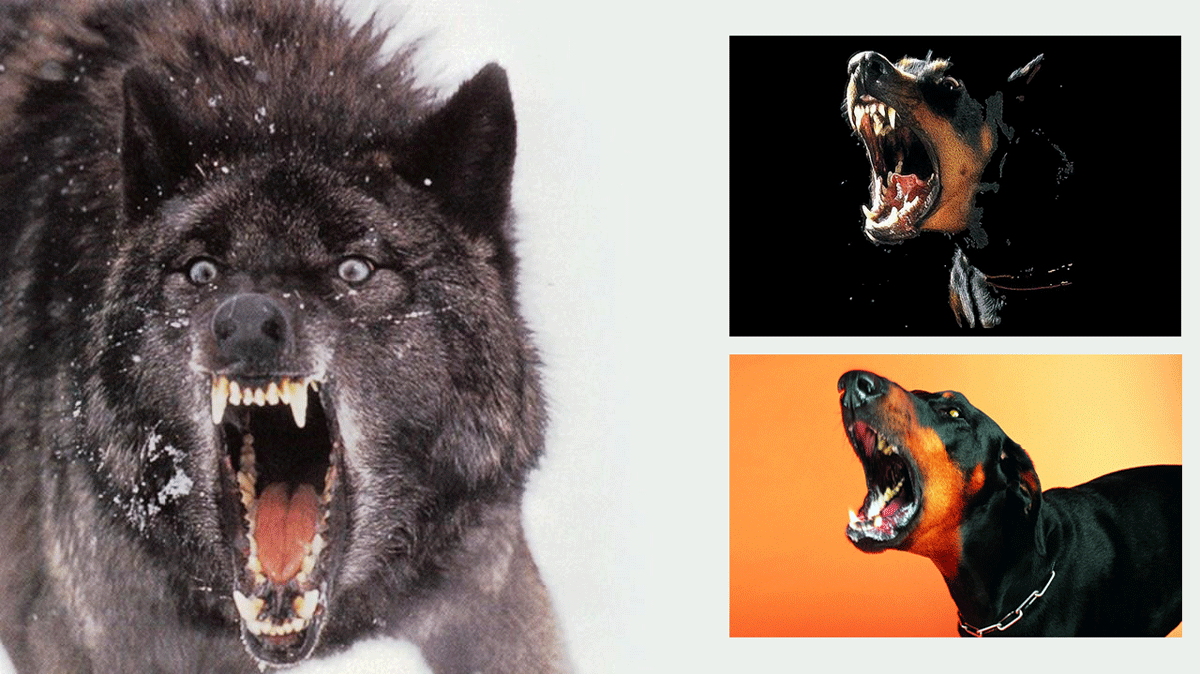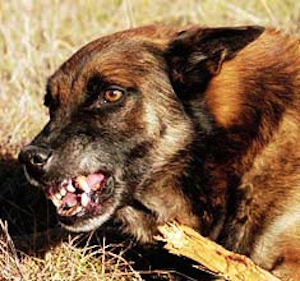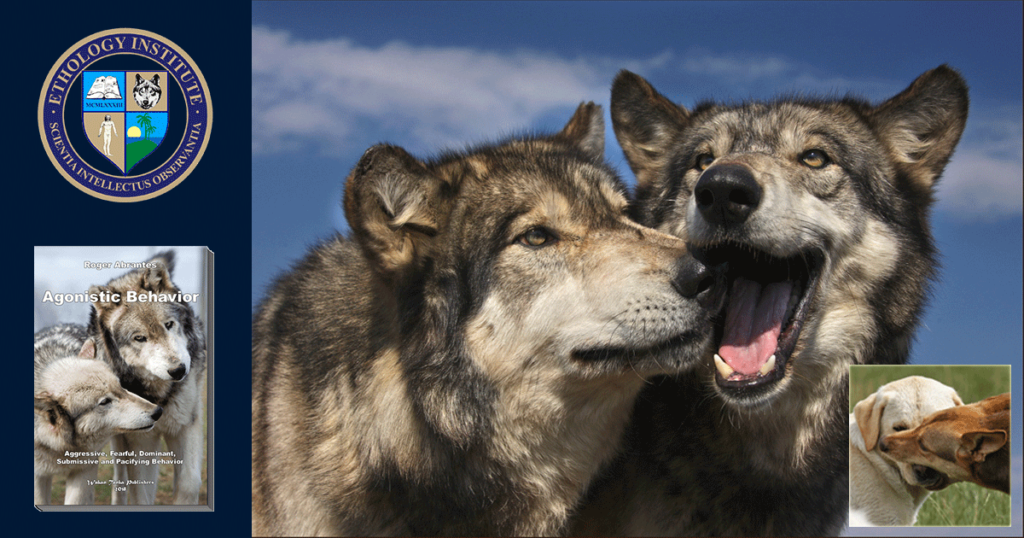In the following, I will give you four definitions of aggression and dominance; and will analyze them determining whether and why they are good or bad definitions.
A Question of Definition and Convention
Behavior is tricky to study because it is highly dynamic depending on many variables. It is even more difficult to describe because nothing, or very little, is as clear cut as we would wish and our brains strive after. The difference between any two behaviors is like the difference between any two colors in the light spectrum. When is red not red but yellow is as tricky to assert as when friendly behavior turns into pacifying, pacifying into submissive, or submissive into fearful. It is, ultimately, a question of definition and convention.
Accuracy, Consistency, and Modesty
Behavior and emotion are intimately connected, and yet we can only see the former and guess about the latter. Generalizations are troublesome and prone to error. These inherent difficulties combined with poor definitions and sloppy use of the terms can only turn a difficult subject-matter into a nearly impossible one. My suggestion to attempt to remedy this is to formulate accurate definitions, to apply terms consistently, and to be modest in our claims and generalizations, leaving plenty of room for alternative hypothesis and improvement.
I will exemplify the problem with some representative statements about dominance and aggression, which I picked from articles on the Internet. The name of their authors is irrelevant in this context because my purpose is not to criticize single persons, only to point out fundamental errors and to help my readers to analyze what they read, to find their bearings, and develop their own educated opinions.
In all fairness, we must appreciate the problem any author faces when attempting to describe an everyday occurrence, like behavior, accurately while living up to a scientific standard; which we frequently register, and convey in daily language. It’s much more difficult than to write a mathematical sentence. “Between a rock and a hard place,” the author tries not to use too many technical terms, which require definitions on their own, putting him or herself at the mercy of everyday language and colloquialisms bound to a myriad of interpretations and misinterpretations. If you’re the author of one of the analyzed statements below, please regard my analysis as an aid. I’m definitely on your side, fully appreciating the burden of the task you so bravely undertook: to define and to explain.
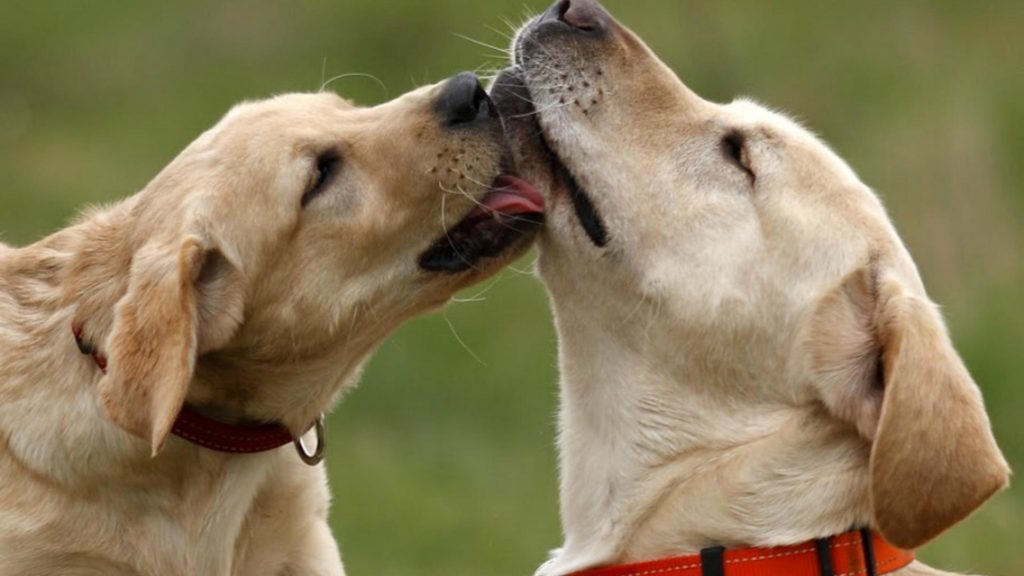
Believe or not, the higher ranking (ethology term) or most distinguished (in human terms) dog is the one on the right. That is the function (and the beauty) of the evolutionarily stable strategy dominant/submissive behavior (when defined correctly). It resolves a confrontation without injury to either party, spending only a manageable amount of energy. The dog on the left shows pacifying behavior, which is a voluntary display of a mild form of submissive behavior. It’s politeness, recognition, in human terms (photo by unknown).
Example 1—A Poor Definition
Example 1: “In animal behavior, dominance is defined as a relationship between individuals that is established through force, aggression and submission in order to establish priority access to all desired resources (food, the opposite sex, preferred resting spots, etc.). A relationship is not established until one animal consistently defers to another.”
The author states that dominance is one kind of relationship: (“dominance (…) is a relationship”) with the function to “(in order to) establish priority access to all desired resources.”
The statement does not tell us explicitly what dominant behavior is, but leaves us guessing that since dominance “is established through force, aggression and submission,” it must be related to these behaviors; but it does not define aggression and submission, which are technical terms.
The statement seems either biased or too restrictive. One individual can establish a dominant (priority access, according to the author) relationship with another through motivation, persuasion, argumentation, bluffing, bribing, all without the use of force or aggression (aggressive behavior), independently of how we understand these terms.
Most social parents establish their dominance status over their offspring not by using aggressive behavior, but because they are better (older, more experienced) at solving problems (this is persuasion and argumentation) or only a limited and inhibited amount of force, which is quantitatively and functionally so different from aggressive behavior, that it deserves a new name (dominant behavior).
In some cases and for many reasons, most commonly age and experience, it is even the lower ranking (in need of protection) that bestows a higher ranking to the other (it is a “you decide”). Aggressive behavior and dominant behavior are, thus, not the same.
A hierarchy maintained employing aggressive behavior tends to be unstable, either because some of the lower-ranking leave the group (estimating that the costs of group membership out-value its benefits), or because they repeatedly challenge the higher ranking. Any hierarchy maintained by dominant behavior tends to be more stable because the lower-ranking individuals have greater benefits at relatively low costs.
The sentence “to all desired resources,” is too daring. We would not dare to say ‘all’ and we doubt very much that any individual ever controls ‘all’ desired resources (depending on the number, of course, but ‘all’ suggests many). No hierarchy is ever more consistent than it is regularly subject to changes. Even in established hierarchies, the highest ranking individuals do not always gain access to particular resources on particular encounters. Persistent dominant behavior from one individual toward the same other individual tends to turn their relationship hierarchical, but regular displays of dominant behavior must maintain it.
The sentence is not a definition of dominant behavior because to be so we would have to substitute dominance with dominant behavior and aggression with aggressive behavior, and we would get “dominant behavior is established through aggressive behavior,” which does not explain anything.
If dominance and aggression are the same, there is no need to call it something else: aggression would do. The term submission seems misplaced: “dominance is established through submission” is a contradiction since one is the antonym of the other. The sentence does not seem to make sense once we begin analyzing it, but we have a hunch of what the problem is: the author is confounding hierarchy with dominance. If we substitute one term by the other, then the sentence makes sense—a relationship can be hierarchical—though, it is still wrong because a hierarchical relationship does not necessarily involve force and aggressive behavior; it can include many other aspects, as we saw.
The sentence “A relationship is not established until one animal consistently defers to another,” is misleading. It gives the impression that no relationship at all exists between two individuals unless one consistently defers to the other, which is not true. There are many examples of relationships (most, as a matter of fact), be it between humans, wolves or dogs, where one of the parties does not consistently defer to the other. Quite the contrary, in most stable relationships, both parties consistently defer to one another.
In the statement above, and in general, we confound dominance with dominant behavior; we confuse a defining characteristic with an attribute.
A dog is not dominant as it is black or short-legged. A dog shows dominant behavior toward (condition 1) when (condition 2).
“A knife is a cutting tool” indicates a defining characteristic (permanent). “This knife is sharp” indicates an attribute (temporary). The correct is: “This knife is sharp to cut meat (=condition 1) today (=condition 2).”
Likewise, “Bongo is dominant toward Rover (=condition 1) when they find a bone (=condition 2).” More correctly, we should write, “Bongo showed today dominant behavior toward Rover when they found a bone.” We can also say, if it is the case, “Bongo shows, more often than not, dominant behavior toward Rover when they find an edible item.”
That is characterizing the behavior, not the individual. What we cannot say is “Bongo is dominant, Rover is submissive” because these are not defining characteristics of an individual.” These are attributes of their behavior under certain conditions even when these conditions seem to be rather encompassing.
Bottom line: The statement is not good because: (1) it defies observational data (aggression is not a necessary condition in a dominance relationship). (2) if aggression is a necessary condition, then we do not need to call it dominance, we can directly call it ‘an aggressive relationship’ (or antagonistic if you prefer a nicer name). (3) it is too restrictive (‘all desired resources,’ ‘a relationship is not established,’ ‘consistently defers’).
Example 2—A Circular Definition
Let us consider another example of a representative sentence, this time about aggression, taken from another article on the Internet.
Example 2: “So what causes aggression? Aggression is a response to something/someone the animal perceives as a threat. Aggression is used to protect the animal through the use of aggressive displays (growling, barking, tooth displays, etc.) or protect the animal through aggressive acts (biting). Aggressive behavior is most frequently caused by fear.”
We miss the definition of “threat” to be able to analyze the sentence conclusively, but assuming that threat means “an intention of imminent harm, danger, or pain” (The Free Dictionary), the statement is false.
A threat is only a threat if it threatens, that is if it succeeds in eliciting fear behavior (apprehended as imminent danger). Otherwise, if the threatened individual does not consider itself under imminent harm, danger or pain, then it is not a threat, it is just an exclamation (information).
Animals respond to threats (not exclamations), which are aggressive behaviors, by either neutralizing the opponent’s aggressive behavior (pacifying behavior), giving up (displaying active or passive submissive behavior) or fleeing (the most effective energy-saving measure when seriously threatened). When threatened, attacking would be the worst possible strategy. If attacking solves the problem, then the threat was not a threat at all (by definition) because it was not dangerous enough to qualify as such.
The only occasion when some animals respond aggressively to threats (not all, some freeze and die) is when pacifying behavior, submissive behavior, and fleeing does not have the desired effect of neutralizing the threatening (aggressive) behavior of an opponent. These are exceptional exceptions.
The sentence “Aggression is used to protect the animal through the use of aggressive displays (…)” is circular. Aggression being synonymous with aggressive behavior and display and act with behavior means that the sentence reads, “Aggressive behavior is used to protect the animal through the use of aggressive behavior or protect the animal through aggressive behavior.”
Furthermore, since the author writes in the passive, it leaves us with the feeling that aggression is some mysterious quality. Who uses it? Where does it come from? Re-writing it in the active, we get the even more nonsensical “The animal uses aggressive behavior to protect itself through the use of aggressive behavior or protect itself through aggressive behavior.” That is not exactly a statement likely to enlighten anyone, quite the opposite.
The sentence “Aggressive behavior is most frequently caused by fear” is the result of our use of terms without having given enough thought to their proper definitions. Fear does not elicit aggressive behavior. It would have been a lethal strategy that natural selection would have eradicated swiftly and once and for all. A cornered animal does not show aggressive behavior because it is fearful. It does so because its natural responses to a fear-eliciting stimulus (pacifying, submission, flight) don’t work.
Example 3—A Better Definition
Let us find out why a third statement, which we also took from the Internet, is much better than the two that we have analyzed above.
Example 3: “Dominance is not a personality trait but a description of a relationship between two or more animals and is related to which animal has access to valued resources such as food, mates, etc.” We can easily improve this statement by avoiding the unclear “is related to” and the passive construction of the sentence: “Dominance is not a personality trait but a description of a relationship between two or more animals; in a dominance relationship, the dominant animal has access to valued resources such as food and mates.” (We also drop the vague and unnecessary “etc.”).
This statement is not as restrictive as the first one we analyzed. For example, it does not claim aggressive behavior as a necessary condition. It allows for more options. It also says what the defined term is not (“not a personality trait”).
Good and Tentative Definitions
The art of making a good definition is to find the right balance between too much and too little and to state only the necessary conditions. A too restrictive definition has fewer chances to be adopted than a broader one, and a too broad definition risks losing its defining function. This definition of dominance is more likely to be accepted and adopted by a more significant number of people than the first one.
A proper definition defines precisely what it is supposed to define, and nothing else. A good definition gives an if-and-only-if condition for when an object or a term satisfies the definition. It is conclusive and exclusive. A good definition should also involve simpler terms than what we are defining.
Sometimes, we are compelled to use working definitions. A working definition is a definition we choose for an occasion and may not fully conform to the final definition. It is a definition at a stage of being developed—a tentative definition that in due time may turn into an established definition.
Example 4—A Good Definition
Example 4: “Dominant behavior is quantitative and quantifiable behavior displayed by an individual with the function of gaining or maintaining temporary access to a particular resource on a particular occasion, versus a particular opponent, without either party incurring injury. If any of the parties incur injury, then the behavior is aggressive and not dominant. Its quantitative characteristics range from slightly self-confident to overtly assertive.”
It is a good definition because it defines a term including and excluding the necessary conditions. It defines something concrete and observable, not a semantic form (it is easier to define “dominant behavior” than “dominance relationship”).
It states a necessary condition to distinguish it from a related technical term, aggressive behavior, even explaining a defining characteristic of the latter.
It does not include other terms needing a definition. It contains enough conditions to justify the use of the term—not too few, risking being synonymous with another term, and not too many, risking being too broad and losing its explanatory value.
It gives an example of its main characteristics in plain words. It does not presuppose any specialized knowledge of a reader to understand it. It is almost impossible not to agree with this definition unless, of course, one wants the term to describe something completely different (which is another matter altogether).
It accepts adjustments and improvements as new data becomes available, the mark of a good definition. In fact, we have modified it numerous times since its inception in the 1980s, thanks to the input of fellow researchers. It’s not the last word on this matter. It is, though, a solid tool to pave our way into increasingly more accurate explanations of a seemingly too complex reality for our brain to grasp.
It is not likely that we’ll find the truth, the only truth and nothing but the truth about behavior anytime soon, if ever, but we believe we can come close(r) to it by being meticulous in our observations, strict in our argumentations, modest in our generalizations, and prudent in our conclusions.
References
- Abrantes, R. 1997. The Evolution of Canine Social Behavior. Wakan Tanka Publishers.
- Abrantes, R. 1997. Dog Language. Wakan Tanka Publishers.
- Abrantes, R. 2014. Canine Muzzle Grasp Behavior—Advanced Dog Language.
- Abrantes, R. 2014. Canine Muzzle Nudge, Muzzle Grasp And Regurgitation Behavior.
- Abrantes, R. 2014. Why Do Dogs Like To Lick Our Faces?
- Akert, R. M., Aronson, E., & Wilson, T.D. (2010). Social Psychology (7th ed.). Upper Saddle River, NJ: Prentice Hall.
- Blair R. J. R. (2004) The roles of orbital frontal cortex in the modulation of antisocial behavior. Brain Cogn55:198–208.
- Bock, Gregory R. and Goode, Jamie A. (eds.) (1996). Genetics of Criminal and Antisocial Behavior. Chichester: John Wiley & Sons.
- Broom, M., Koenig, A., Borries, C. (2009).Variation in dominance hierarchies among group-living animals: modeling stability and the likelihood of coalitions, Behavioral Ecology, Volume 20, Issue 4, 1 July 2009, Pages 844–855, https://doi.org/10.1093/beheco/arp069
- Brown, C. (2015). Fish intelligence, sentience and ethics. Animal cognition, 18(1), 1-17.
- Copi, I., et al (2014) Introduction to Logic. Pearson Education Limited. Harlow.
- Coppinger, R. and Coppinger, L. 2001. Dogs: a Startling New Understanding of Canine Origin, Behavior and Evolution. Scribner.
- Craig, I. W., Halton, K. E. (2009). Hum Genet (2009) 126:101–113.
- Darwin, C. 1872. The Expressions of the Emotions in Man and Animals. John Murray (the original edition).
- Dawkins, R. (2006) The Selfish Gene. Oxford University Press, USA.
- Fox, M. 1972. Behaviour of Wolves, Dogs, and Related Canids. Harper and Row.
- Javeed, Q. S. and Vidhate. N. J. (2012). A Study Of Aggression And Ego Strength Of Indoor Game Players And Outdoor Game Players. Indian Streams Research Journal, Volume 2, Issue. 7, Aug 2012.
- Lopez, Barry H. (1978). Of Wolves and Men. J. M. Dent and Sons Limited.
- Maynard Smith, J. (1972). Game Theory and The Evolution of Fighting. On Evolution. Edinburgh University Press. ISBN 0-85224-223-9.
- Maynard Smith, J. (1982). Evolution and the Theory of Games. ISBN 0-521-28884-3.
- McFarland, D. (1982) The Oxford Companion to Animal Behaviour. Oxford University Press, Oxford.
- McFarland, D. (1998) Animal Behaviour. Benjamin Cummings. 3rd ed.Maynard Smith, J, Harper, D. G. C., Brookfeld, J. F. Y. (1988) The Evolution of Aggression: Can Selection Generate Variability? Philos Trans R Soc Lond B Biol Sci 319:557–570.
- McCauley, C. (2000) Some Things Psychologists Think They Know about Aggression and Violence. In Teaching About Violence, Vol 4. Spring 2000)
- Miles DR, Carey G (1997) Genetic and environmental architecture of human aggression. J Pers Soc Psychol72:207–217.
- Nash, J. F. (May 1950). Non-Cooperative Games (PDF). PhD thesis. Princeton University. Retrieved May 24,2015.Nelson, Randy Joe (ed.) (2006). Biology of Aggression. Oxford: Oxford University Press.
- Mech, L. D. 1970. The wolf: the ecology and behavior of an endangered species. Doubleday Publishing Co., New York.
- Mech, L. David (1981). The Wolf: The Ecology and Behaviour of an Endangered Species. University of Minnesota Press.
- Mech, L. D. 1988. The arctic wolf: living with the pack. Voyageur Press, Stillwater, Minn.
- Mech. L. D. and Boitani, L. 2003. Wolves: Behavior, Ecology, and Conservation. University of Chicago Press.
- Schacter, Daniel L. (2011). Psychology Second Edition. New York: Worth Publishers.
- Scott, J. P. and Fuller, J. L. 1998. Genetics and the Social Behavior of the Dog. University of Chicago Press.
- Shermer, M. (2004). The Science of Good and Evil. New York: Times Books.
- Siever LJ (2008) Neurobiology of aggression and violence. Am J Psychiatry 165:429–442
- Tremblay R. E., Hartup W. W., Archer, J. (2005) Developmental origins of aggression. Guildford Press, New York.
- Yamamoto H, Nagai K, Nakagawa H. (1984). Additional evidence that the suprachiasmatic nucleus is the center for regulation of insulin secretion and glucose homeostasis. Brain Res304:237–241.
- Zimen, E. 1975. Social dynamics of the wolf pack. In The wild canids: their systematics, behavioral ecology and evolution. Edited by M. W. Fox. Van Nostrand Reinhold Co., New York. pp. 336-368.
- Zimen, E. 1982. A wolf pack sociogram. In Wolves of the world. Edited by F. H. Harrington, and P. C. Paquet. Noyes Publishers, Park Ridge, NJ.
Featured image: Is this head-to-head confrontation a display of aggressive or dominant behavior? We need good definitions to decide correctly for one or the other (photo by unknown).
Learn more in our course Ethology. Ethology studies the behavior of animals in their natural environment. It is fundamental knowledge for the dedicated student of animal behavior as well as for any competent animal trainer. Roger Abrantes wrote the textbook included in the online course as a beautiful flip page book. Learn ethology from a leading ethologist.

Featured Course of the Week
The 20 Principles Animal training is a craft: half science and half art. This course and the included online book give you the 20 indispensable principles you must know to become a skilled animal trainer. It is the best crash course in animal training one can wish for.
Featured Price: € 148.00 € 98.00


